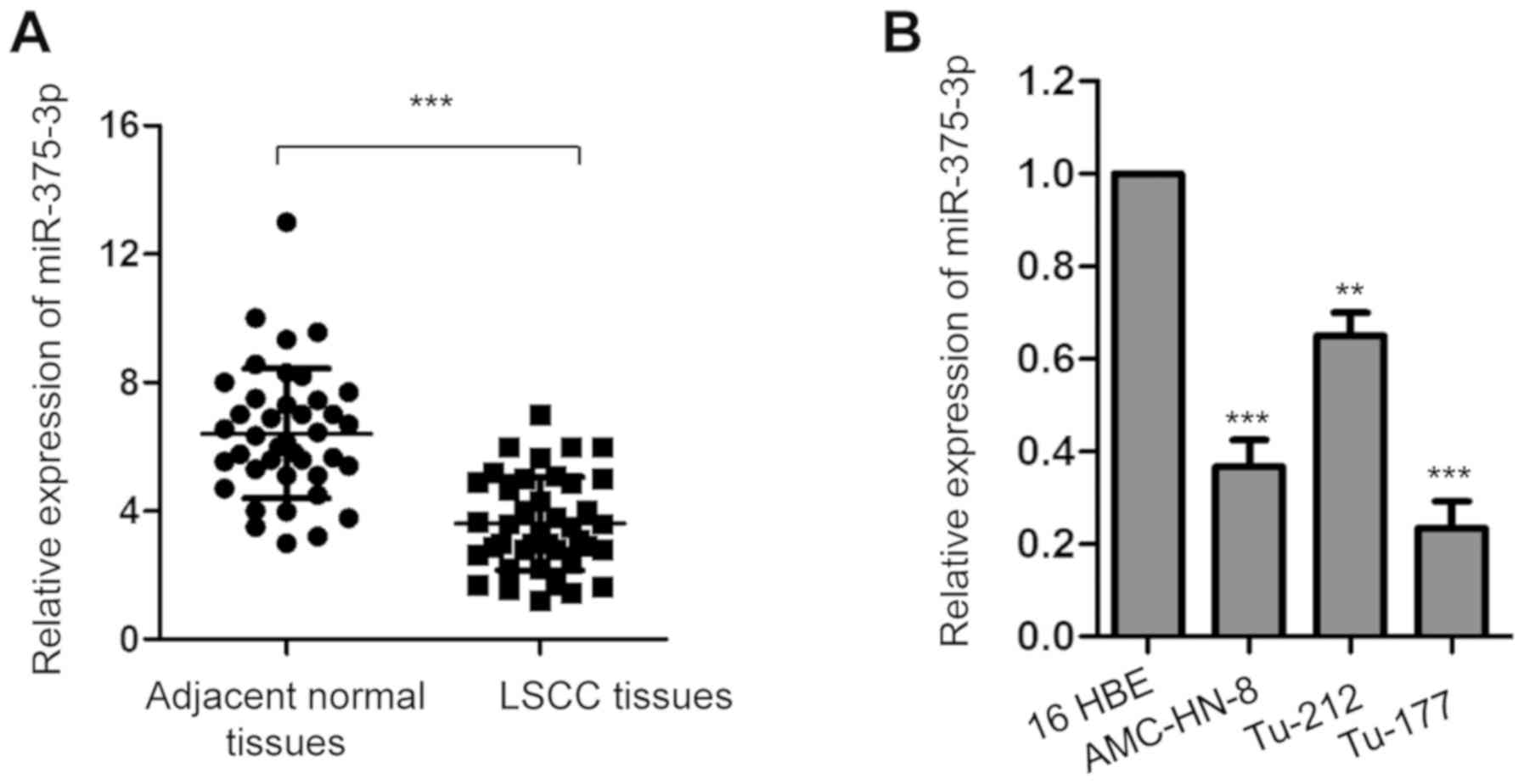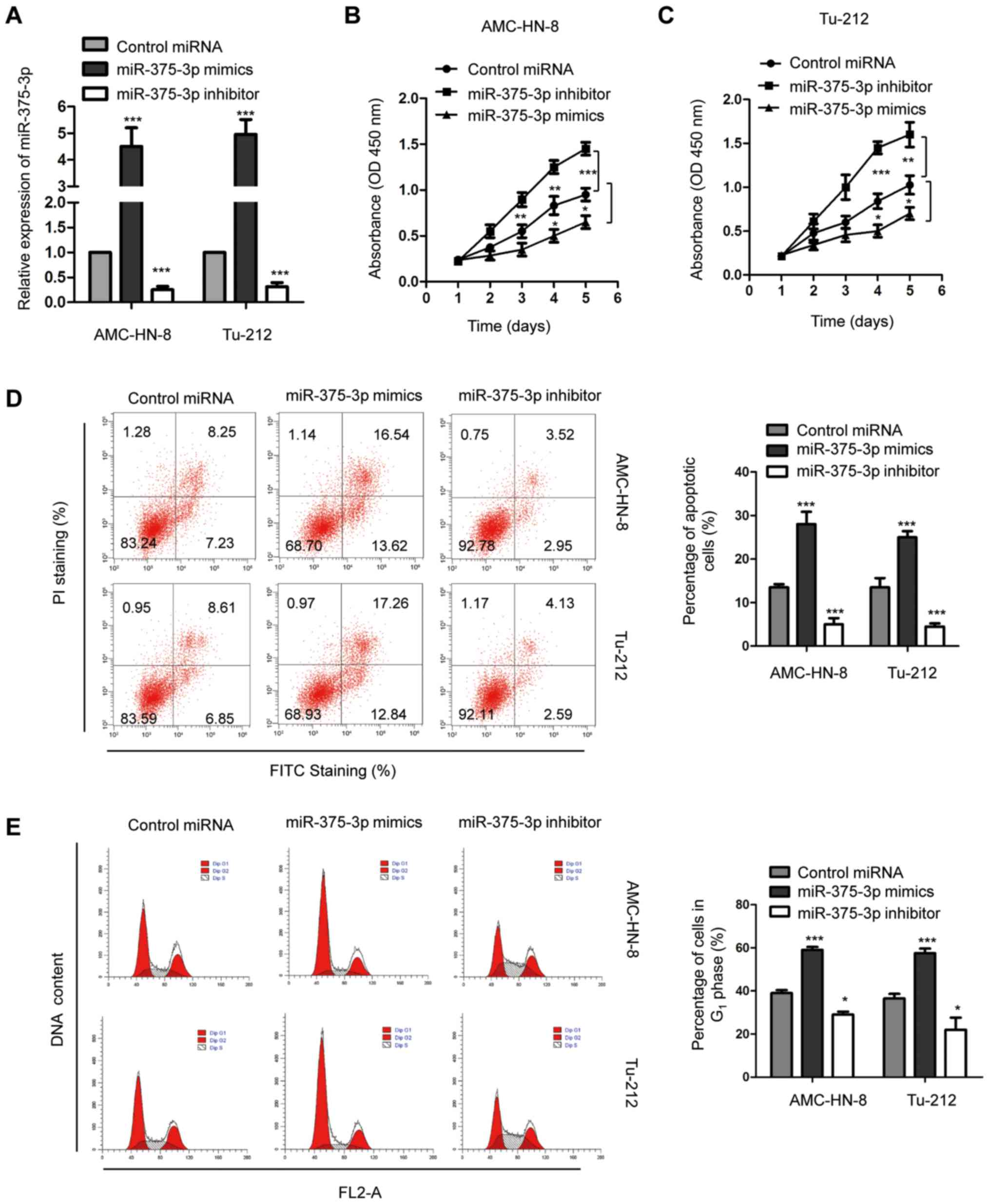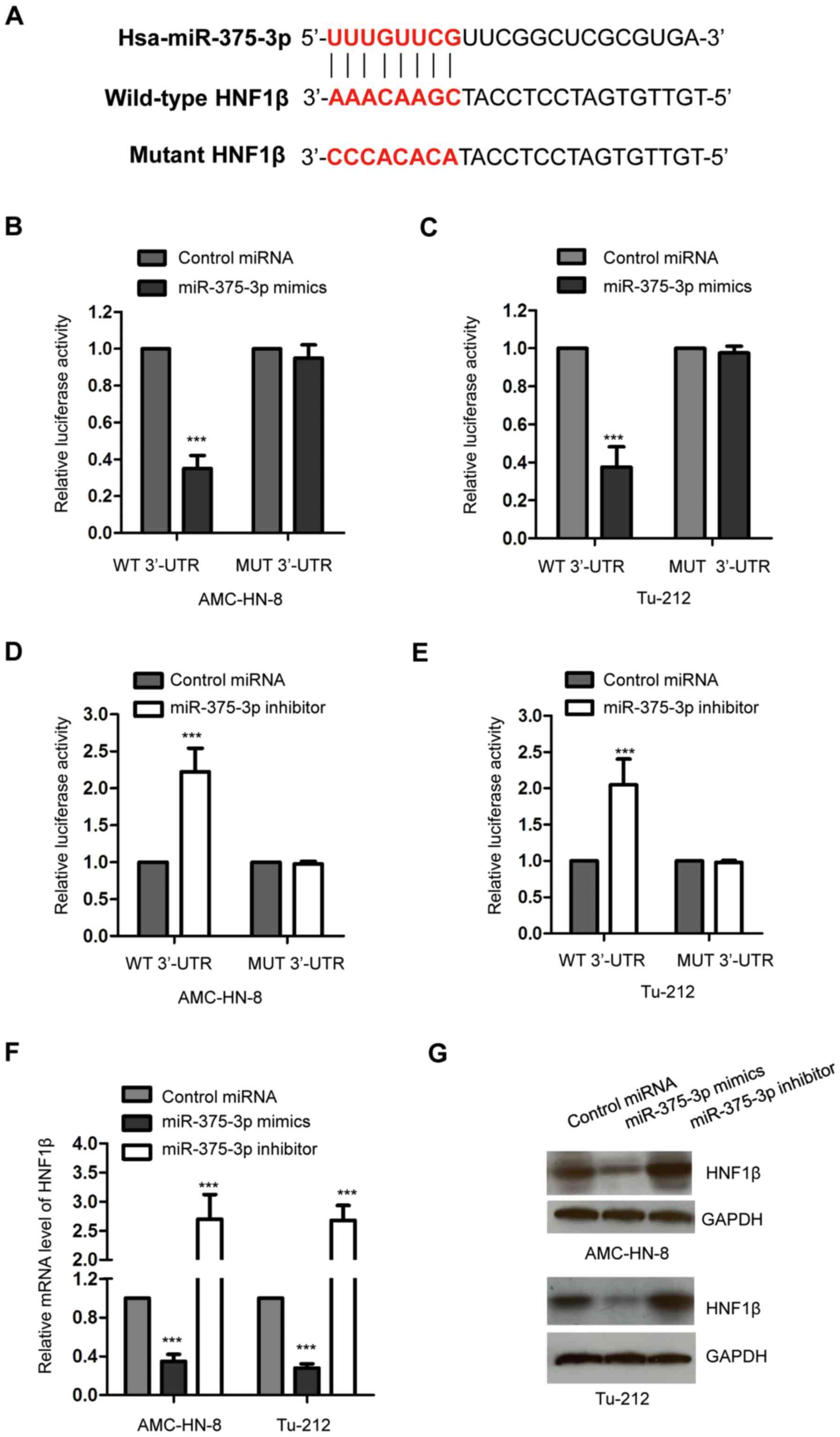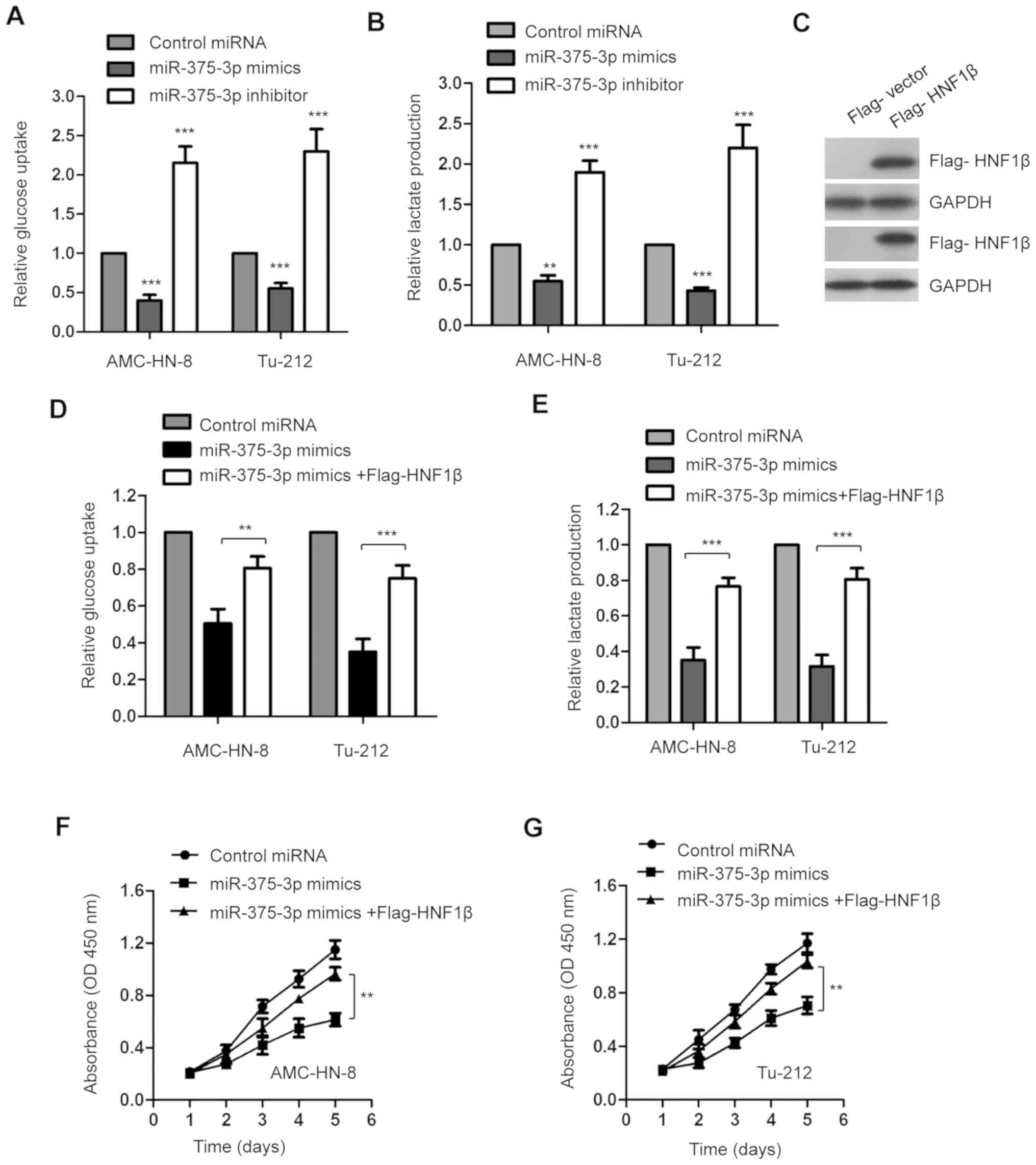|
1
|
Lu ZM, Lin YF, Jiang L, Chen LS, Luo XN,
Song XH, Chen SH and Zhang SY: Micro-ribonucleic acid expression
profiling and bioinformatic target gene analyses in laryngeal
carcinoma. OncoTargets Ther. 7:525–533. 2014. View Article : Google Scholar
|
|
2
|
Tataru D, Mak V, Simo R, Davies EA and
Gallagher JE: Trends in the epidemiology of head and neck cancer in
London. Clin Otolaryngol. 42:104–114. 2017. View Article : Google Scholar : PubMed/NCBI
|
|
3
|
Gao C and Hu S: miR-506 is a
YAP1-dependent tumor suppressor in laryngeal squamous cell
carcinoma. Cancer Biol Ther. 20:826–836. 2019. View Article : Google Scholar : PubMed/NCBI
|
|
4
|
Marur S and Forastiere AA: Head and Neck
Squamous Cell Carcinoma: Update on Epidemiology, Diagnosis, and
Treatment. Mayo Clin Proc. 91:386–396. 2016. View Article : Google Scholar : PubMed/NCBI
|
|
5
|
Palumbo A Jr, De Martino M, Esposito F,
Fraggetta F, Neto PN, Valverde Fernandes P, Santos IC, Dias FL,
Nasciutti LE, Meireles Da Costa N, et al: HMGA2, but not HMGA1, is
overexpressed in human larynx carcinomas. Histopathology.
72:1102–1114. 2018. View Article : Google Scholar : PubMed/NCBI
|
|
6
|
Ozmen OA, Alpay M, Saraydaroglu O, Demir
UL, Kasapoglu F, Coskun HH and Basut OI: Prognostic significance of
soft tissue deposits in laryngeal carcinoma. Braz J
Otorhinolaryngol. 84:566–573. 2018. View Article : Google Scholar : PubMed/NCBI
|
|
7
|
Ambros V: The functions of animal
microRNAs. Nature. 431:350–355. 2004. View Article : Google Scholar : PubMed/NCBI
|
|
8
|
Bartel DP: MicroRNAs: Genomics,
biogenesis, mechanism, and function. Cell. 116:281–297. 2004.
View Article : Google Scholar : PubMed/NCBI
|
|
9
|
Fabian MR, Sonenberg N and Filipowicz W:
Regulation of mRNA translation and stability by microRNAs. Annu Rev
Biochem. 79:351–379. 2010. View Article : Google Scholar : PubMed/NCBI
|
|
10
|
Mohr AM and Mott JL: Overview of microRNA
biology. Semin Liver Dis. 35:3–11. 2015. View Article : Google Scholar : PubMed/NCBI
|
|
11
|
Gentilin E, Degli Uberti E and Zatelli MC:
Strategies to use microRNAs as therapeutic targets. Best Pract Res
Clin Endocrinol Metab. 30:629–639. 2016. View Article : Google Scholar : PubMed/NCBI
|
|
12
|
Momtazi AA, Shahabipour F, Khatibi S,
Johnston TP, Pirro M and Sahebkar A: Curcumin as a MicroRNA
Regulator in Cancer: A Review. Rev Physiol Biochem Pharmacol.
171:1–38. 2016. View Article : Google Scholar : PubMed/NCBI
|
|
13
|
Iorio MV and Croce CM: MicroRNA
dysregulation in cancer: Diagnostics, monitoring and therapeutics.
A comprehensive review. EMBO Mol Med. 9:8522017. View Article : Google Scholar : PubMed/NCBI
|
|
14
|
Asadzadeh Z, Mansoori B, Mohammadi A,
Aghajani M, Haji-Asgarzadeh K, Safarzadeh E, Mokhtarzadeh A, Duijf
PHG and Baradaran B: microRNAs in cancer stem cells: Biology,
pathways, and therapeutic opportunities. J Cell Physiol.
234:10002–10017. 2019. View Article : Google Scholar : PubMed/NCBI
|
|
15
|
Hosseinahli N, Aghapour M, Duijf PHG and
Baradaran B: Treating cancer with microRNA replacement therapy: A
literature review. J Cell Physiol. 233:5574–5588. 2018. View Article : Google Scholar : PubMed/NCBI
|
|
16
|
Kwak PB, Iwasaki S and Tomari Y: The
microRNA pathway and cancer. Cancer Sci. 101:2309–2315. 2010.
View Article : Google Scholar : PubMed/NCBI
|
|
17
|
Farazi TA, Spitzer JI, Morozov P and
Tuschl T: miRNAs in human cancer. J Pathol. 223:102–115. 2011.
View Article : Google Scholar : PubMed/NCBI
|
|
18
|
Li X, Wang HL, Peng X, Zhou HF and Wang X:
miR-1297 mediates PTEN expression and contributes to cell
progression in LSCC. Biochem Biophys Res Commun. 427:254–260. 2012.
View Article : Google Scholar : PubMed/NCBI
|
|
19
|
Yungang W, Xiaoyu L, Pang T, Wenming L and
Pan X: miR-370 targeted FoxM1 functions as a tumor suppressor in
laryngeal squamous cell carcinoma (LSCC). Biomed Pharmacother.
68:149–154. 2014. View Article : Google Scholar : PubMed/NCBI
|
|
20
|
Luo M, Sun G and Sun JW: miR-196b affects
the progression and prognosis of human LSCC through targeting
PCDH-17. Auris Nasus Larynx. 46:583–592. 2019. View Article : Google Scholar : PubMed/NCBI
|
|
21
|
Han L, Tang M, Xu X, Jiang B, Wei Y, Qian
H and Lu X: miR-143-3p suppresses cell proliferation, migration,
and invasion by targeting melanoma-associated antigen A9 in
laryngeal squamous cell carcinoma. J Cell Biochem. Oct 9–2018.(Epun
ahead of print).
|
|
22
|
Niu JT, Zhang LJ, Huang YW, Li C, Jiang N
and Niu YJ: miR-154 inhibits the growth of laryngeal squamous cell
carcinoma by targeting GALNT7. Biochem Cell Biol. 96:752–760. 2018.
View Article : Google Scholar : PubMed/NCBI
|
|
23
|
Chen X, Zhang L and Tang S: MicroRNA-4497
functions as a tumor suppressor in laryngeal squamous cell
carcinoma via negatively modulation the GBX2. Auris Nasus Larynx.
46:106–113. 2019. View Article : Google Scholar : PubMed/NCBI
|
|
24
|
Jamali Z, Asl Aminabadi N, Attaran R,
Pournagiazar F, Ghertasi Oskouei S and Ahmadpour F: MicroRNAs as
prognostic molecular signatures in human head and neck squamous
cell carcinoma: A systematic review and meta-analysis. Oral Oncol.
51:321–331. 2015. View Article : Google Scholar : PubMed/NCBI
|
|
25
|
Zheng J: Energy metabolism of cancer:
Glycolysis versus oxidative phosphorylation (Review). Oncol Lett.
4:1151–1157. 2012. View Article : Google Scholar : PubMed/NCBI
|
|
26
|
Akram M: Mini-review on glycolysis and
cancer. J Cancer Educ. 28:454–457. 2013. View Article : Google Scholar : PubMed/NCBI
|
|
27
|
Li XB, Gu JD and Zhou QH: Review of
aerobic glycolysis and its key enzymes - new targets for lung
cancer therapy. Thorac Cancer. 6:17–24. 2015. View Article : Google Scholar : PubMed/NCBI
|
|
28
|
Amano Y, Mandai M, Yamaguchi K, Matsumura
N, Kharma B, Baba T, Abiko K, Hamanishi J, Yoshioka Y and Konishi
I: Metabolic alterations caused by HNF1β expression in ovarian
clear cell carcinoma contribute to cell survival. Oncotarget.
6:26002–26017. 2015. View Article : Google Scholar : PubMed/NCBI
|
|
29
|
Mandai M, Amano Y, Yamaguchi K, Matsumura
N, Baba T and Konishi I: Ovarian clear cell carcinoma meets
metabolism; HNF-1β confers survival benefits through the Warburg
effect and ROS reduction. Oncotarget. 6:30704–30714. 2015.
View Article : Google Scholar : PubMed/NCBI
|
|
30
|
Okamoto T, Mandai M, Matsumura N,
Yamaguchi K, Kondoh H, Amano Y, Baba T, Hamanishi J, Abiko K,
Kosaka K, et al: Hepatocyte nuclear factor-1β (HNF-1β) promotes
glucose uptake and glycolytic activity in ovarian clear cell
carcinoma. Mol Carcinog. 54:35–49. 2015. View Article : Google Scholar : PubMed/NCBI
|
|
31
|
Kato N and Motoyama T: Hepatocyte nuclear
factor-1beta (HNF-1beta) in human urogenital organs: Its expression
and role in embryogenesis and tumorigenesis. Histol Histopathol.
24:1479–1486. 2009.PubMed/NCBI
|
|
32
|
Kobayashi H, Yamada Y, Kanayama S,
Furukawa N, Noguchi T, Haruta S, Yoshida S, Sakata M, Sado T and Oi
H: The role of hepatocyte nuclear factor-1beta in the pathogenesis
of clear cell carcinoma of the ovary. Int J Gynecol Cancer.
19:471–479. 2009. View Article : Google Scholar : PubMed/NCBI
|
|
33
|
Bockenhauer D and Jaureguiberry G:
HNF1B-associated clinical phenotypes: The kidney and beyond.
Pediatr Nephrol. 31:707–714. 2016. View Article : Google Scholar : PubMed/NCBI
|
|
34
|
Bártů M, Dundr P, Němejcová K, Tichá I,
Hojný H and Hájková N: The Role of HNF1B in Tumorigenesis of Solid
Tumours: A Review of Current Knowledge. Folia Biol (Praha).
64:71–83. 2018.PubMed/NCBI
|
|
35
|
Zheng J, Liu X, Xue Y, Gong W, Ma J, Xi Z,
Que Z and Liu Y: TTBK2 circular RNA promotes glioma malignancy by
regulating miR-217/HNF1β/Derlin-1 pathway. J Hematol Oncol.
10:522017. View Article : Google Scholar : PubMed/NCBI
|
|
36
|
Livak KJ and Schmittgen TD: Analysis of
relative gene expression data using real-time quantitative PCR and
the 2(-Delta Delta C(T)) method. Methods. 25:402–408. 2001.
View Article : Google Scholar : PubMed/NCBI
|
|
37
|
Edge SB and Compton CC: The American Joint
Committee on Cancer: the 7th edition of the AJCC cancer staging
manual and the future of TNM. Ann Surgl Oncol. 17:1471–1474. 2010.
View Article : Google Scholar
|
|
38
|
Voigt JJ: Recommendations of the FNCLCC
Sarcoma Group for pathologic management of soft tissue sarcoma in
adults. Ann Pathol. 19:1531999.(In French). PubMed/NCBI
|
|
39
|
Shen Z, Yuan J, Tong Q, Hao W, Deng H, Li
Q, Zhou C, Hu Y and Xu J: Long non-coding RNA AC023794.4-201 exerts
a tumor-suppressive function in laryngeal squamous cell cancer and
may serve as a potential prognostic biomarker. Oncol Lett.
20:774–784. 2020.PubMed/NCBI
|
|
40
|
Fan Y, Xia X, Zhu Y, Diao W, Zhu X, Gao Z
and Chen X: Circular RNA expression profile in laryngeal squamous
cell carcinoma revealed by microarray. Cell Physiol Biochem.
50:342–352. 2018. View Article : Google Scholar : PubMed/NCBI
|
|
41
|
Yu CH, Xing FY, Zhang JY, Xu JQ and Li YC:
A combination of mRNA expression profile and miRNA expression
profile identifies detection biomarkers in different tumor stages
of laryngeal squamous cell carcinoma. Eur Rev Med Pharmacol Sci.
22:7296–7304. 2018.PubMed/NCBI
|
|
42
|
Zhang F and Cao H: MicroRNA-143-3p
suppresses cell growth and invasion in laryngeal squamous cell
carcinoma via targeting the k-Ras/Raf/MEK/ERK signaling pathway.
Int J Oncol. 54:689–701. 2019.PubMed/NCBI
|
|
43
|
Kaboli PJ, Rahmat A, Ismail P and Ling KH:
MicroRNA-based therapy and breast cancer: A comprehensive review of
novel therapeutic strategies from diagnosis to treatment. Pharmacol
Res. 97:104–121. 2015. View Article : Google Scholar : PubMed/NCBI
|


















